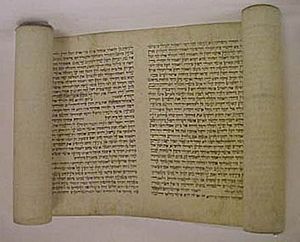Codex facts for kids

A codex (say "KOH-deks") is like an early book. It has separate pages, just like the books we use today. This is different from a scroll, which is one long, rolled-up piece of writing. Codices were usually written by hand on materials like vellum or parchment, which are types of animal skin.
How Codices Became Popular
The Romans first created the codex from wooden writing tablets. Before codices, most written works were on scrolls. The change from scrolls to codices was a huge step in making books, even before the printing press was invented!
Codices changed how books looked and were used. They were also very strong and lasted a long time. Many people link the rise of codices to the growth of Christianity. Early Christians used codices for the Bible.
A Roman poet named Martial first wrote about codices in the 1st century AD. He liked how easy they were to use. By about 300 AD, there were as many codices as scrolls. By the 6th century, codices had completely replaced scrolls in the Greco-Roman world.
Why Codices Were Better
Codices had many benefits compared to scrolls:
- They were more compact and easier to carry.
- They were sturdier and lasted longer.
- They used materials more efficiently because you could write on both sides of a page.
- It was much easier to find specific information. With a codex, you could quickly flip to any page. With a scroll, you had to unroll it to find what you needed.
The switch from scrolls to codices happened around the same time people started using parchment more than papyrus for writing. In Egypt, by the 5th century, there were ten times more codices than scrolls. By the 6th century, scrolls were hardly used for literature anymore.
Related pages
Images for kids
-
A reproduction of a Roman-style wax tablet, which helped lead to the codex.
-
An early medieval bookcase with about ten codices, shown in the Codex Amiatinus (around 700 AD).
-
The Codex Mendoza, an Aztec codex from the early 16th century, showing what towns owed as tribute.
-
The cover of the Carolingian gospel book, the Codex Aureus of St. Emmeram, made around 870 AD.
-
A page from the Codex Manesse. Most manuscripts had lines to guide the writing.
See also
 In Spanish: Códice para niños
In Spanish: Códice para niños








